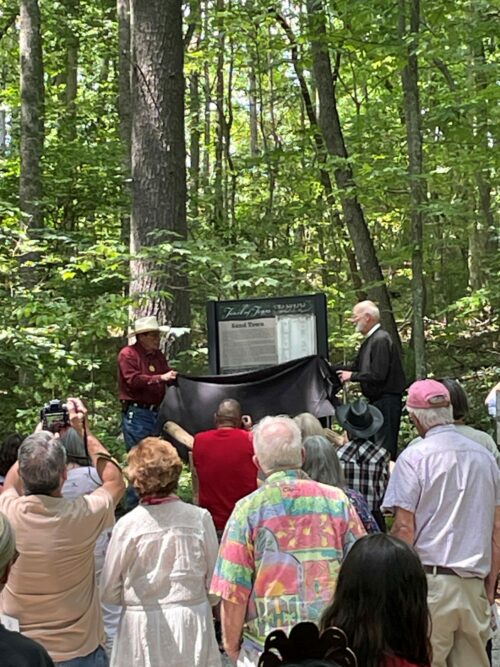FRANKLIN, N.C. – A sign dedication took place recognizing the location of the post-Removal Cherokee community of Sand Town (Nvyohi) on Saturday, June 3. The event happened at the St. John’s Episcopal Church in the Cartoogechaye valley, at 542 St. John’s Church Road in Franklin, N.C. This is also the site of Sand Town headman Jim Woodpecker’s and his wife Sally’s final resting place.

Dr. Tom Belt, left, and Rev. Carl Southerland unveil the sign during a dedication ceremony at the site of the Cherokee community of Sand Town (Nvyohi) in Franklin, N.C. on Saturday, June 3. (DAWN ARNEACH/One Feather photo)
Hosted by St. John’s and the North Carolina Trail of Tears Association (NCTOTA), 144 attendees were welcomed by the Reverend Carl Southerland. After some Cherokees had escaped or avoided the forced Removal in 1838, an early settler to the area, William Siler, sold land to Woodpecker for the establishment of a new Cherokee town composed of seventeen families along Muskrat Creek. Sand Town became a thriving community until after the Civil War. Two leaders from Sand Town, George Bushyhead and John Jackson, later became instrumental in the formation of the Eastern Band of Cherokee Indians (EBCI).
Special guests included Woodpecker descendants Monica Wildcatt and Butch Goings, along with many Siler descendants, including Rev. Southerland. After the “Cherokee Anthem”, performed by Amy West, attendees heard from Jack Baker, the president of the National Trail of Tears Association, and Will Chavez, a Remember the Removal Legacy Rider (1984) and the assistant editor of the Cherokee Phoenix. Both were in the area to attend the Remember the Removal Bike Riders Send-off the evening before at Kituwah Mound. Six riders from Cherokee Nation and five riders from the EBCI attended the sign dedication prior to their leaving on a 950-mile journey by bicycle to retrace the Trail of Tears from New Echota, Georgia to Tahlequah, Oklahoma.
Dr. Brett Riggs, the Distinguished Sequoyah professor at Western Carolina University, presented the history of Sand Town to attendees, followed by a blessing at the Woodpecker memorial by Rev. Southerland and Cherokee elder Dr. Tom Belt. The unveiling of the new NCTOTA Sand Town signage immediately followed. This is the first of several post-Removal communities NCTOTA plans to recognize in Western North Carolina.
The NCTOTA is one of nine state chapters in the National Trail of Tears Association, which serves to recognize, mark, and interpret the National Trail of Tears Historic Trail and sites pertinent to Removal era history with the National Parks Service.
- North Carolina Trail of Tears Association release



